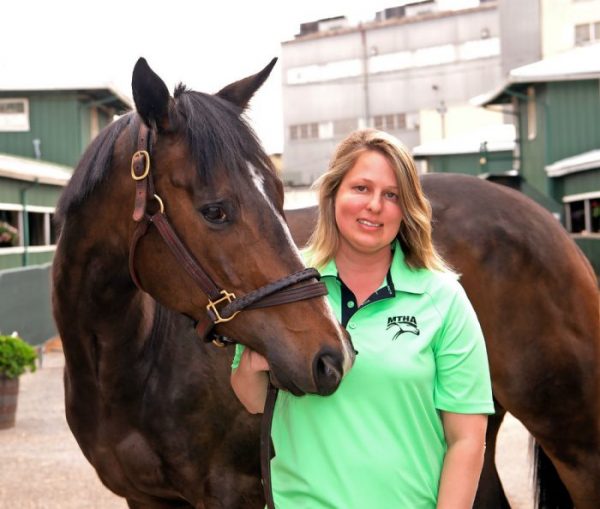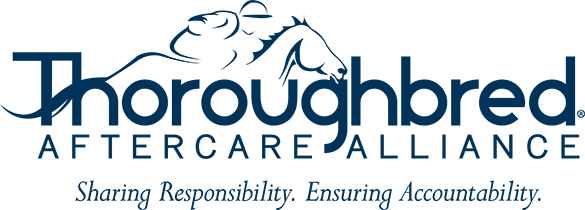Getting members from various facets of the Thoroughbred industry to come together and agree on something can be difficult, if not impossible.
But when it comes to aftercare in the state of Maryland, that seemingly impossible agreement became reality with Beyond the Wire. The program, which was launched in early 2017, is an initiative by the Maryland Thoroughbred Horsemen’s Association, the Maryland Jockey Club, the Maryland Horse Breeders Association, and the Maryland jockeys.
Similar to what other jurisdictions have—with New York’s Take the Lead and the California Retirement Management Account (CARMA)—Beyond the Wire facilitates a safe first exit from racing for horses and places them at Thoroughbred Aftercare Alliance-accredited organizations for retraining, rehabbing, and rehoming.
Specifically, Beyond the Wire works with TAA-accredited MidAtlantic Horse Rescue, Foxie G Foundation, New Vocations, Akindale Thoroughbred Rescue, After the Races, and Life Horse Inc.
TAA marketing and communications manager Erin Shea talked to Beyond the Wire’s program administrator, Jessica Hammond, about the program and her advice for other racing jurisdictions on how to set up a similar network.
Erin Shea: When a trainer has a horse that needs to retire, what does Beyond the Wire do? What’s the process of the horse going from the track to a new off-track home?
Jessica Hammond: When a trainer and owner decide to retire a horse, they contact me and fill out an intake form. I evaluate the horse along with a track veterinarian to assess overall health and soundness, while noting any other pertinent information such as temperament, vices, etc. I also take a picture of the horse for our website and to send to the receiving facility so that they can see the horse they are considering taking.
All of the facilities we use are accredited by the Thoroughbred Aftercare Alliance. Once a program accepts the horse, I set up shipping and send them, along with a stipend, to be retrained, rehabilitated if needed, and ultimately adopted.
ES: Why does Beyond the Wire like to work with TAA-accredited organizations?
JH: Working with TAA-accredited facilities gives us reassurance that we are sending our horses to places that offer the highest standards of care.
We can also be assured that accredited programs are skilled in the handling and retraining of Thoroughbreds, have decent facilities, and are financially responsible with the donations and grants they are given. TAA does all of the legwork by evaluating facilities in person and requiring those programs to successfully complete a rigorous application process. They even require programs to be re-accredited at regular intervals.
Lastly, all of our facilities will also take a horse back at any time for any reason—that type of safety net is invaluable to us and our horses.
ES: How has the first year been for Beyond the Wire, and what’s the reaction been from the racing community? Any unexpected challenges that you had to address?
JH: The first year has been great. We have placed about 70 horses so far and almost half of them have already been adopted.
I honestly can’t say that there have been any unexpected challenges. I came into this work with a decent amount of experience having been an owner, with a husband who was a trainer. We both have a passion for aftercare and had already been supporting local efforts. There are challenges, but none that are unexpected. I work with a flexible board that is willing to make adjustments quickly as necessary, which helps maintain efficiency. Ultimately, the Maryland racing industry wants a functional and successful program. Beyond the Wire really benefits from the support of the Maryland Thoroughbred Horsemen’s Association, the Maryland Jockey Club, and the Maryland Horse Breeders Association, both financially and professionally.
The racing community has definitely been appreciative of the program, which is an industry-wide initiative. Most owners and trainers prioritize a safe retirement for their horses, and I think there is already a great amount of confidence in our program in that regard.
ES: What are the future plans for Beyond the Wire?
JH: We have begun to offer continuing education opportunities and that facet of Beyond the Wire that will continue.
Our first seminar was with veterinarian surgeon Dr. Patty Hogan, and was attended by about 70 trainers, assistant trainers, and owners. I have been in communication with a few professors at the University of Kentucky that are affiliated with the Grayson-Jockey Club Research Foundation, to create a new, upcoming seminar.
It is important to the health and well being of racehorses that the people handling them and making decisions for them are as educated as possible in regards to medical and training issues.
ES: What would you tell someone who is looking to get a similar program off the ground in their area?
JH: I would tell them to just get started. There are so many resources available now with existence of the TAA and a national network of programs that are doing great work. Make phone calls, read articles, talk to your horsemen, drum up support from your local industry members, and reach out to the programs you admire.
We are all in this to help racehorses live full lives and to ensure a continuing, thriving racing industry. The vast majority of people who work in aftercare are happy to share their time and experience—we went to Take the Lead in New York to get ideas before starting our program.
I would also tell people to remind fellow owners, trainers, grooms, and so on, that we live in a different world than we did 20 years ago and when it comes to animal welfare, this is a good thing. Aftercare for our racehorses is now an expectation from the public and the public has clout in regards to the survival of our sport. Remind people of this and then get to work helping the animals and the sport that we all love.
PHOTO: Jim McCue














